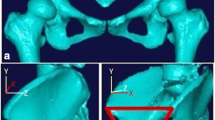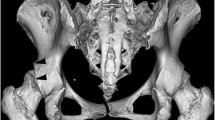Abstract
Purpose
Three-dimensional computed tomography (CT) is the method of choice in understanding the morphological changes after periacetabular osteotomy in children. We studied different parameters and compared aspects of operated hip (OH) with non-operated hip (NOH) to define the maneuver that promotes normalization of the hip during repositioning of the acetabulum.
Methods
A total of 22 patients with 25 OHs underwent CT control scans an average of 4 years after surgery. The patients, with a mean age of 6.8 years, had either Legg-Calvé-Perthes disease (12 cases) or dysplasia (10 cases).The measurements included the anterior and posterior coverage angles of the hip and version of the acetabulum on axial CT views. The 3D reconstructed images measured the inclination of the antero– and postero–lateral lips, the external rotation and the anterior inclination of the acetabulum.
Results
The mean anterior coverage angle was 27° for OHs, 31° for NOHs, and 12° versus 10.3° for the posterior coverage angle. Acetabular anteversion was 2° for OHs (6.3° in the dysplastic OHs) and 6° for NOHs. The mean angle of inclination of the antero–lateral lip was 37° for OHs, 47° for NOHs, and the postero–lateral lip inclination was 56° for OHs and 67° for NOHs. Inferior 3D views showed a mean internal acetabular rotation of 1.5° (4.8° in the dysplastic OH), 3° for NOH. The anterior acetabular inclination angle measured with lateral 3D views was 6° for OHs, 11° for NOHs.
Conclusion
Our analysis demonstrated a mean anteversion of the acetabulum despite normalization of the anterior coverage of the hip, particularly in the dysplastic group, in which the osteotomized fragments had anteversion superior to NOH. The unexpected external rotation used to improve anterior coverage of a coax magna in Legg-Calvé-Perthes disease was responsible for the retroversion and the decrease of the posterior coverage.







Similar content being viewed by others
References
Frick S, Kim S, Wenger D (2000) Pre- and postoperative three-dimensional computed tomography analysis of triple innominate osteotomy for hip dysplasia. J Pediatr Orthop 20:116–123
Azuma H, Taneda H, Igarashi H, Fujioka M (1990) Preoperative and postoperative assessment of rotational acetabular osteotomy for dysplastic hips in children by three dimensional surface reconstruction computed tomography imaging. J Pediatr Orthop 10:33–38
Kim HT, Wenger DR (1997) The morphology of residual acetabular deficiency in childhood hip dysplasia: three dimensional computed tomographic analysis. J Pediatr Orthop 17:637–647
Klaue K, Wallin A, Ganz R (1988) CT evaluation of coverage and congruency of the hip prior to osteotomy. Clin Orthop 232:15–25
Jawish R, Ghorayeb J, Khalife R (2007) Quadruple and juxta-articular pelvic osteotomy in children using anterior approach: technique and results. J Pediatr Orthop B 16:10–15
Stulberg SD, Cooperman DR, Wallensten R (1981) The natural history of Legg-Calvé-Perthes disease. J Bone Joint Surg Am 63:1095
Buckley SL, Sponseller PD, Magid D (1991) The acetabulum in congenital and neuromuscular hip instability. J Pediatr Orthop 11:498–501
Smith B, Kasser J, Hey L, Jaramillo D, Millis M (1997) Postreduction computed tomography in developmental dislocation of the hip: part I: analysis of measurement reliability. J Pediatr Orthop 17:626–630
Abel MF, Sutherland DH, Wenger DR, Mubarak SJ (1994) Evaluation of CT scans and 3-D reformatted images for quantitative assessment of the hip. J Pediatr Orthop 14:48–53
Weiner L, Kelley M, Ulin R, Wallach D (1993) Development of the acetabulum and hip: computed tomography analysis of the axial plane. J Pediatr Orthop 13:421–425
Ganz R, Klaue K, Vinh TS, Mast JW (1988) A new periacetabular osteotomy for treatment of hip dysplasias: technique and preliminary results. Clin Orthop 232:26–36
Trousdale RT, Ekkernkamp A, Ganz R, Wallrichs SL (1995) Periacetabular and intertrochanteric osteotomy for the treatment of osteoarthrosis in dysplastic hips. J Bone Joint Surg Am 77:73–85
Tonnis D (1987) Pelvic operations for dysplasia of the hip. In: Tonnis D (ed) Congenital dysplasia and dislocation of the hip. Springer, Heidelberg, pp 356–385
Tonnis D, Behrens K, Tscharani F (1981) A modified technique of the triple pelvic osteotomy. J Pediatr Orthop 1:241–249
Le Coeur P (1965) Correction of the abnormal acetabular orientation with isthmic osteotomy of the ilium (in French). Rev Chir Orthop 51:211–222
Azuma H, Taneda H, Igarashi H (1991) Evaluation of acetabular coverage: three-dimensional CT imaging and the modified pelvic inlet view. J Pediatr Orthop 11:765–769
Salter RB, Hall JE (1983) Combined open reduction and innominate osteotomy for congenital dislocation of the hip. Strateg Orthop Surg 2:1–16
Author information
Authors and Affiliations
Corresponding author
About this article
Cite this article
Jawish, R., Khalife, R. & Ghorayeb, J. Three-dimensional computed tomography analysis and anteversion study after periacetabular osteotomy of pelvis in children. J Child Orthop 1, 357–363 (2007). https://doi.org/10.1007/s11832-007-0063-z
Received:
Accepted:
Published:
Issue Date:
DOI: https://doi.org/10.1007/s11832-007-0063-z




